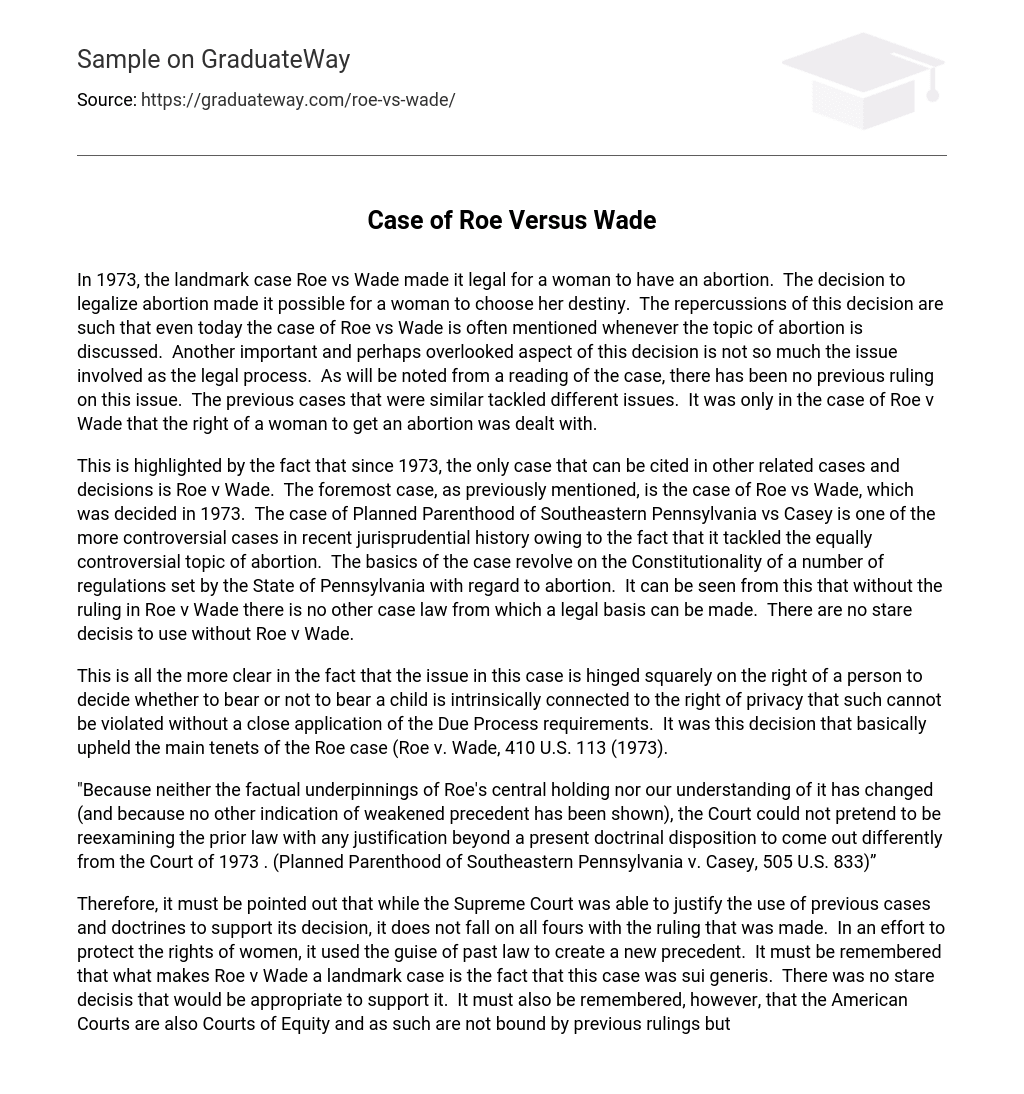In 1973, the landmark case Roe vs Wade made it legal for a woman to have an abortion. The decision to legalize abortion made it possible for a woman to choose her destiny. The repercussions of this decision are such that even today the case of Roe vs Wade is often mentioned whenever the topic of abortion is discussed. Another important and perhaps overlooked aspect of this decision is not so much the issue involved as the legal process. As will be noted from a reading of the case, there has been no previous ruling on this issue. The previous cases that were similar tackled different issues. It was only in the case of Roe v Wade that the right of a woman to get an abortion was dealt with.
This is highlighted by the fact that since 1973, the only case that can be cited in other related cases and decisions is Roe v Wade. The foremost case, as previously mentioned, is the case of Roe vs Wade, which was decided in 1973. The case of Planned Parenthood of Southeastern Pennsylvania vs Casey is one of the more controversial cases in recent jurisprudential history owing to the fact that it tackled the equally controversial topic of abortion. The basics of the case revolve on the Constitutionality of a number of regulations set by the State of Pennsylvania with regard to abortion. It can be seen from this that without the ruling in Roe v Wade there is no other case law from which a legal basis can be made. There are no stare decisis to use without Roe v Wade.
This is all the more clear in the fact that the issue in this case is hinged squarely on the right of a person to decide whether to bear or not to bear a child is intrinsically connected to the right of privacy that such cannot be violated without a close application of the Due Process requirements. It was this decision that basically upheld the main tenets of the Roe case (Roe v. Wade, 410 U.S. 113 (1973).
“Because neither the factual underpinnings of Roe’s central holding nor our understanding of it has changed (and because no other indication of weakened precedent has been shown), the Court could not pretend to be reexamining the prior law with any justification beyond a present doctrinal disposition to come out differently from the Court of 1973 . (Planned Parenthood of Southeastern Pennsylvania v. Casey, 505 U.S. 833)”
Therefore, it must be pointed out that while the Supreme Court was able to justify the use of previous cases and doctrines to support its decision, it does not fall on all fours with the ruling that was made. In an effort to protect the rights of women, it used the guise of past law to create a new precedent. It must be remembered that what makes Roe v Wade a landmark case is the fact that this case was sui generis. There was no stare decisis that would be appropriate to support it. It must also be remembered, however, that the American Courts are also Courts of Equity and as such are not bound by previous rulings but may change them according to the needs of the present.
Roe vs. Wade-January 22, 1973 is a class action challenging the constitutionality of the Texas criminal abortion laws, which proscribe procuring or attempting an abortion except on medical advice for the purpose of saving the mother’s life. There are several admendments that this class action falls under. However ruling that declaratory, though not injuctive, relief was warranted, the court declared the abortion statues void as vague overbroadly infringing those plaintiffs’ Ninth and Fourteenth Amendment rights. State criminal abortion laws, except from criminality only a life-saving procedure on the mother’s behalf without regard to the stage of her pregnancy and other interests involved the Due Process Clause of the Fourteenth Amendment, which protects against state action the right to privacy, including a woman’s qualified right to terminate her pregnancy.
www.womenshistory.about.com/library/etext/gov/bl_roe_a.htm
In my opinion the ruling back in 1973 was a ruling based on the women’s primary health of the pregnancy. Mainly a life-saving issue. Even though the 38 reaffirmations, could make this a “stare decisis.” It is a difficult ruling to keep this a settle law because of the personal views, religions and considerations for the amendments it seems to base the original ruling on, (life-saving).wc 187
While the post certainly makes a valid point, it must be pointed out that the reaffirmations and previous doctrines have no application to the analysis of this case. Stare Decisis is not wholly applicable to justify the ruling of the Supreme Court because this was neither an expansion nor an extension of previous doctrines. The ruling in Roe v Wade, if analyzed in the context of the situation at that time, is essentially a novel issue and as such could find no suitable previous rulings. In fact, even assuming that such was an expansion or extension of previous rulings related to life saving, it would still constitute a novel issue because it deals with an unborn child and that of a mother.





